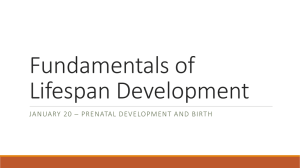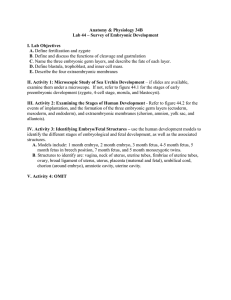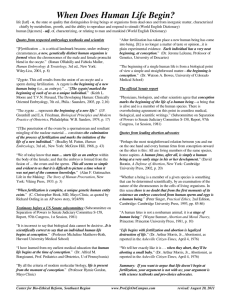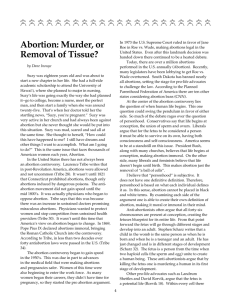When Does Human Life Begin?
advertisement
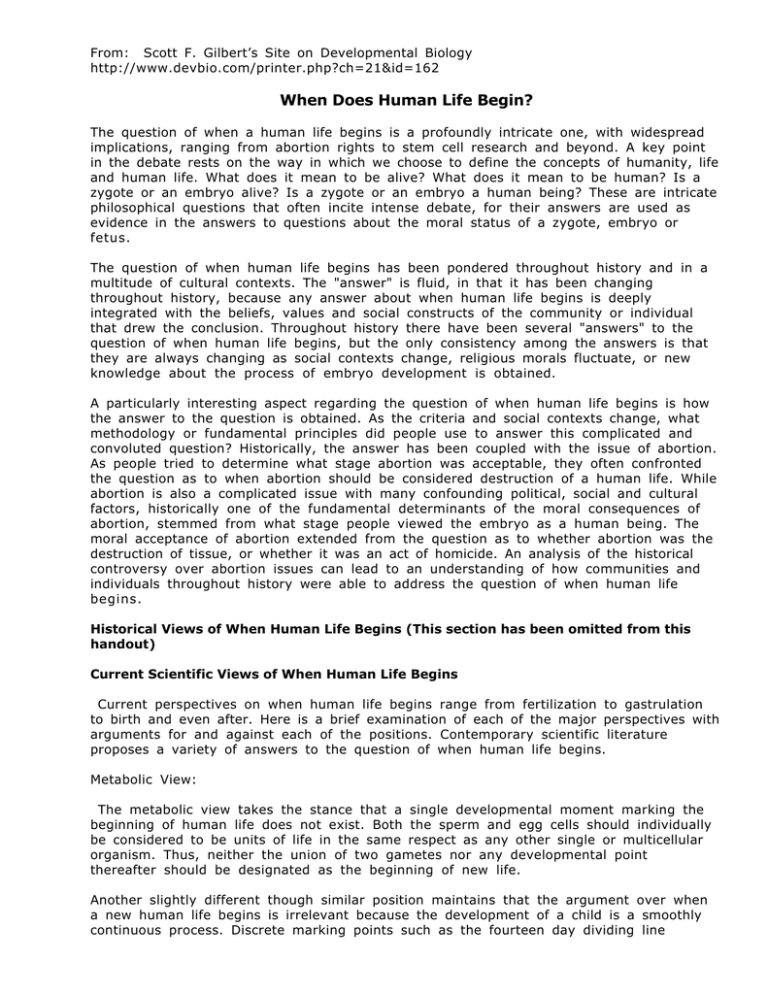
From: Scott F. Gilbert’s Site on Developmental Biology http://www.devbio.com/printer.php?ch=21&id=162 When Does Human Life Begin? The question of when a human life begins is a profoundly intricate one, with widespread implications, ranging from abortion rights to stem cell research and beyond. A key point in the debate rests on the way in which we choose to define the concepts of humanity, life and human life. What does it mean to be alive? What does it mean to be human? Is a zygote or an embryo alive? Is a zygote or an embryo a human being? These are intricate philosophical questions that often incite intense debate, for their answers are used as evidence in the answers to questions about the moral status of a zygote, embryo or fetus. The question of when human life begins has been pondered throughout history and in a multitude of cultural contexts. The "answer" is fluid, in that it has been changing throughout history, because any answer about when human life begins is deeply integrated with the beliefs, values and social constructs of the community or individual that drew the conclusion. Throughout history there have been several "answers" to the question of when human life begins, but the only consistency among the answers is that they are always changing as social contexts change, religious morals fluctuate, or new knowledge about the process of embryo development is obtained. A particularly interesting aspect regarding the question of when human life begins is how the answer to the question is obtained. As the criteria and social contexts change, what methodology or fundamental principles did people use to answer this complicated and convoluted question? Historically, the answer has been coupled with the issue of abortion. As people tried to determine what stage abortion was acceptable, they often confronted the question as to when abortion should be considered destruction of a human life. While abortion is also a complicated issue with many confounding political, social and cultural factors, historically one of the fundamental determinants of the moral consequences of abortion, stemmed from what stage people viewed the embryo as a human being. The moral acceptance of abortion extended from the question as to whether abortion was the destruction of tissue, or whether it was an act of homicide. An analysis of the historical controversy over abortion issues can lead to an understanding of how communities and individuals throughout history were able to address the question of when human life begins. Historical Views of When Human Life Begins (This section has been omitted from this handout) Current Scientific Views of When Human Life Begins Current perspectives on when human life begins range from fertilization to gastrulation to birth and even after. Here is a brief examination of each of the major perspectives with arguments for and against each of the positions. Contemporary scientific literature proposes a variety of answers to the question of when human life begins. Metabolic View: The metabolic view takes the stance that a single developmental moment marking the beginning of human life does not exist. Both the sperm and egg cells should individually be considered to be units of life in the same respect as any other single or multicellular organism. Thus, neither the union of two gametes nor any developmental point thereafter should be designated as the beginning of new life. Another slightly different though similar position maintains that the argument over when a new human life begins is irrelevant because the development of a child is a smoothly continuous process. Discrete marking points such as the fourteen day dividing line between a zygote and an embryo are entirely artificial constructions of biologists and doctors in order to better categorize development for academic purposes. This position is supported by recent research that has revealed that fertilization itself is not even an instantaneous event, but rather a process that takes 20-22 hours between the time the sperm penetrates the outermost layers of the egg and the formation of a diploid cell (Kuhse 1988). Genetic View: The genetic view takes the position that the creation of a genetically unique individual is the moment at which life begins. This event is often described as taking place at fertilization, thus fertilization marks the beginning of human life. During this developmental event, the genes originating from two sources combine to form a single individual with a different and unique set of genes. One of the most popular arguments for fertilization as the beginning of human life is that at fertilization a new combination of genetic material is created for the first time; thus, the zygote is an individual, unique from all others. Although the opinion that life begins at fertilization is the most popular view among the public, many scientists no longer support this position, as an increasing number of scientific discoveries seem to contradict it. One such discovery in the last twenty years is that research has shown that there is no "moment of fertilization" at all. Scientists now choose to view fertilization as a process that occurs over a period of 12-24 hours. After sperm are released they must remain in the female reproductive tract for seven hours before they are capable of fertilizing the egg. Approximately ten hours are required for the sperm to travel up to the fallopian tube where they find the egg. The meeting of the egg and the sperm itself is not even an instantaneous process, but rather a complex biochemical interaction through which the sperm ultimately reaches the inner portion of the egg. Following fertilization, the chromosomes contained within the sperm and the chromosomes of the egg meet to form a diploid organism, now called a zygote, over a period of 24 hours. (Shannon and Wolter 1990). Thus, even if one were to argue that life begins at fertilization, fertilization is not a moment, but rather a continuous process lasting 12-24 hours, with an additional 24 hours required to complete the formation of a diploid individual. The most popular argument against the idea that life begins at the moment of fertilization has been dubbed the "twinning argument." The main point of this argument is that although a zygote is genetically unique from its parents from the moment a diploid organism is formed; it is possible for that zygote to split into two or more zygotes up until 14 or 15 days after fertilization. Even though the chances of twinning are not very great, as long as there is the potential for it to occur the zygote has not completed the process of individuation and is not an ontological individual. Proponents of this view often propose the following hypothetical situation: Suppose that an egg is fertilized. At that moment a new life begins; the zygote gains a "soul," in the Catholic line of thought, or "personhood" in a secular line of thought. Then suppose that the zygote splits to form twins. Does the soul of the zygote split as well? No, this is impossible. Yet no one would argue that twins share the same "soul" or the same "personhood." Thus, supporters of this view maintain that the quality of "soul" or "personhood" must be conferred after there is no longer any potential for twinning. (Shannon and Wolter 1990) The argument that human life begins at the moment that chromosomes of the sperm meet the chromosomes of the egg to form a genetically unique individual is also endangered by the twinning argument because genetic uniqueness is not a requirement for an individual human life. "Genetic uniqueness" can be shared by multiple individuals, particularly indentical twins. Thus, this argument continues, the moment at which a unique individual human forms is the not the moment when its genetic code is determined, but rather the moment when the zygote can no longer split into multiple individuals. In addition to twinning, there are other complexities that further confound the idea of the moment of conception. Just as it possible for a zygote to form two or more individuals before it is implanted in the uterus, it is also possible for it to not continue to develop at all, but rather just become a part of the placenta. (Shannon and Wolter 1990). It is estimated that more the 50% of the fertilized eggs abort spontaneously and never become children (see Gilbert 2003). Or, if the zygote splits into multiple zygotes, it is also possible for these to recombine before implantation. All of these possibilities are examples of the ways in which the individuation of the zygote is incomplete until it has been implanted in the uterus. Embryological View: In contrast to the genetic view, the embryological view states that human life originates not at fertilization but rather at gastrulation. Human embryos are capable of splitting into identical twins as late as 12 days after fertilization resulting in the development of separate individuals with unique personalities and different souls, according to the religious view. Therefore, properties governing individuality are not set until after gastrulation. This view is endorsed by a host of contemporary scientists such as Renfree (1982), C. Grobstein (1988) and McLaren. This view of when life begins has also been adopted as the official position of the British government. The implications of a belief in this view include giving support to controversial forms of contraception including the "morning after" pill and contragestational agents as long as they are administered during the first two weeks of pregnancy. One of the most popular positions among philosophers is the perspective that life begins at the point of gastrulation, that point at which the zygote is an ontological individual and can no longer become two individuals. Gastrulation commences at the beginning of the third week of pregnancy, when the zygote, now known as an embryo is implanted into the uterus of the mother. The cells are now differentiated into three categories that will give rise to the different types of body tissue. (Shannon and Wolter 1990). After gastrulation the zygote is destined to form no more than one human being. The philosophers who support this position argue that there exists a difference between a human individual and a human person. A zygote is both human and numerically single and thus a human individual. However, because individuality is not certain until implantation is complete, and because individuality is a necessary condition of personhood, the zygote is not yet a human person. (Ford 1988; Shannon and Wolter 1990; McCormick 1991). Catholic scholars Shannon and Wolter (1990) describe this eloquently saying, "An individual is not an individual, and therefore not a person, until the process of restriction is complete and determination of particular cells has occurred. Then, and only then, it is clear that another individual cannot come from the cells of this embryo." Some supporters of the fertilization position find fault in this argument by claiming that the potential of twinning is a technicality and not strong enough to support the claim that human life does not begin until gastrulation. Alan Holland puts forth the view that just because a zygote has the possibility to divide into multiple individuals does not mean that it is not an individual before it divides. As an analogy, he presents the case of the worm that is clearly a single individual worm until it is cut into two when it becomes two individual worms. (Holland 1990). Some would also argue that in the discussion of when human life begins the question of whether a zygote will eventually become one individual or multiple individuals is irrelevant. The key point is that at least one human life may begin as the result of the zygote, and thus human life began at the creation of the zygote, fourteen days before gastrulation. Neurological view: Although most cultures identify the qualities of humanity as different from other living organisms, there is also a universal view that all forms of life on earth are finite. Implicit in the later view is the reality that all life has both a beginning and an end, usually identified as some form of death. The debate surrounding the exact moment marking the beginning of a human life contrasts the certainty and consistency with which the instant of death is described. Contemporary American (and Japanese) society defines death as the loss of the pattern produced by a cerebral electroencephalogram (EEG). If life and death are based upon the same standard of measurement, then the beginning of human life should be recognized as the time when a fetus acquires a recognizable EEG pattern. This acquisition occurs approximately 24- 27 weeks after the conception of the fetus and is the basis for the neurological view of the beginning of human life. These principles of the neurological view of the beginning of human life are presented in The Facts of Life, a book written by Harold Morowitz and James Trefil in 1992 concerning the abortion controversy. An electroencephalogram (EEG) is a simple medical procedure in which electrodes are attached to different locations on a patient's head and the voltage difference over time is measured between the two points. The voltage data is plotted against time to produce "brain waves" with up and down voltage oscillations that are representative of the organized electrical activity of the brain (Morowitz and Trefil 1992). Medical professionals use a patient's EEG pattern to identify a broad spectrum of mental states. Although EEGs are often used as a diagnostic tool, the exact mechanism behind how an EEG pattern is linked to an individual's cerebral neuron activity remains a mystery (Morowitz and Trefil 1992). Despite lacking a precise explanation for the connection between the EEG and neural activity, there is a strong argument that the unique and highly recognizable EEG pattern produced by a mature brain is a defining characteristic of humanity (Morowitz and Trefil 1992). Therefore, the moment that a developing fetus first exhibits an EEG pattern consistent with that of a mature brain is indicative of the beginning of human life. It is from this point and onward during development that the fetus is capable of the type of mental activity associated with humanity (Morowitz and Trefil 1992). Because the state of modern technology still prohibits EEGs in utero, brain activity data for humans at various stages of development has been gathered using premature infants. Observations to date have led to the conclusion that 25 weeks of gestation is required for the formation of synapses needed for recognizable neural activity. At this point in development, the recognizable signals exist only as intermittent bursts that interrupt periods of random activity (Morowitz and Trefil 1992). This conclusion is summarized by Donald Scott who in his book Understanding the EEG wrote, "Attempts have been made to record cerebral activity of premature infants and they have succeeded (only) if the gestational age was 25 weeks or more (Morowitz and Trefil 1992)." Such claims, as well as arguments that endorse an opposite argument, are for many the foundation for any dispute over defining the inception of human life. Consequently, the principles of the neurological view are tenets in the debate over another controversial subject: abortion. Champions for a fetus's right to life often claim that the brain of a human fetus begins to show electrical activity at a remarkably early age. A key moment in the history of the abortion debate is the production and release of "The Silent Scream," an influential abortion film that graphically depicts the fetal response to its termination. The video accompanies the abortion of a 12-week-old fetus with the words "Now this little person at twelve weeks is a fully formed absolutely identifiable human being. He has had brain waves for at least six weeks..." (Morowitz and Trefil 1992). Although such arguments appeal to both the emotion by depicting an infant, though still developing, in a moment of pain and crisis and the intellect by presenting a scientific line of reasoning, the position presented by the film conflicts widely accepted developmental theory. For instance, the film contends that a fetus has brain waves after 12 weeks and suggest, even in the title "The Silent Scream," that it reacts to its termination with fear and pain. These contentions contradict scientific evidence that indicates neural connections in the cerebral cortex have yet to develop in a 12-week-old fetus. Lacking these basic neural networks, the developing fetus is incapable of feeling the emotions recognized as fear or pain (Morowitz and Trefil 1992). The film's position is further contrasted by evidence that suggests a 12- week-old fetus is not yet capable to take direct actions in response to a thought. The developing fetus is therefore incapable of recognizing potential danger and unable to either be fearful of it or actively evade it through movement or any other willful activity (Morowitz and Trefil 1992). (For information concerning how photographs of the embryo are often misrepresented on anti-abortion literature and websites, see Images of Embryos Used by Anti-Abortion Activists.) In addition to presenting 25 weeks as a critical developmental landmark, other proponents of the neurological view believe that events of the eighth week of human gestation represent the key moments marking the beginning of human life. Contemporary philosophical arguments for designating week 8 as the beginning of human life proceed in accordance with the following format: humanness requires rational thought and rational thought requires a brain and a nervous system. Philosophers who present such arguments contest that an embryo is not a human being until it has a rudimentary nervous system. At week 8, the embryo has completed organogenesis, meaning it has simple, undeveloped versions of all the basic organ systems, including the nervous system (Shannon and Wolter 1990) Philosophers who subscribe to this perspective pay close attention to the progressively increasing complexity of the nervous system or the first weeks and months of pregnancy. At week 5 the first neurons begin to appear, at week 6 "the first synapses ... can be recognized," and at 7.5 weeks the embryo displays its first reflexes in response to stimulus. (Shannon and Wolter 1990). Thus around week 8 the embryo has a basic three-neuron circuit, the foundation of a nervous system necessary for rational thought. (Shannon and Wolter 1990). It should come as no surprise that this contemporary philosophical debate also consists of a second argument, which is in direct opposition to the aforementioned position. There are philosophers who believe that the capacity for rational thought is indeed a prerequisite of humanness, but that an 8-week-old embryo does not have the capacity for rational thought. At 8 weeks an embryo displays reflexes that are the result of its budding nervous system, but it does not yet have the structures necessary to engage in true rational activity in contrast to mere reflex motivated movement. (Shannon and Wolter, 1990) A third developmental landmark presented by proponents of the neurological view occurs at 20 weeks. Some advocates of the philosophy that a prerequisite for humanness is the capacity for rational thought believe that the existence of a primitive nervous system after 8 weeks, with the ability to respond by reflex to stimulation, does not amount to rational thought. The embryological landmark of 20 weeks marks the completion of the development of the thalamus, a region of the brain, which enables the integration of the nervous system. Philosophers who support this view therefore believe that only after 20 weeks of gestation can the embryo be said to have the capacity for rational thought. The precept at the heart of the neurological view of the beginning of human life is the significant development of neural pathways that are critical for characteristic human brain activity. The formation of these neural connections is often viewed to culminate in the acquisition of humanness, a stage during the third trimester of human gestation when the overwhelming majority of neural pathways in the cerebral cortex are established (Morowitz and Trefil 1992). The contemporary concept of the acquisition of humanness was developed and elaborated during the later half of the twentieth century by theological and biological leaders who emphasized the importance of the cerebral cortex in characterizing humanness. The Jesuit scholar and anthropologist scientist Pierre Teilhard de Chardin presented his belief that the transcendence of humanity was dependant upon the successful maturation of the cerebral cortex. Bernard Haring, a permanent Catholic theologian of the 1970s argued that individuality and the uniqueness of personal characteristics and activities originated from the cerebral cortex. A decade later, the anatomist Paul Glees argued "the (cerebral cortex) represents the signature of a genetically unique person" (Morowitz and Trefil 1992) The contemporary idea of the acquisition of humanness is based on the contemporary theories of developmental embryology. Cerebral nerve cells accumulate in number and continually differentiate through the end of the second trimester of human pregnancy (Morowitz and Trefil 1992). However, it is not until the seventh month of gestation that a significant number of connections between the newly amassed neurons begin to take form. It is only after the neurons are linked via synapse connections that the fetus is thought to acquire humanness. Just as a pile of unconnected microchips is incapable of functioning and is therefore not called a computer, the unconnected neurons of the pre 24-week fetal brain lack the capacity to function, thus the developing fetus has yet to acquire humanness (Morowitz and Trefil 1992). Ecological / Technological view: Advocates of the neurological view contend that human life begins when a developing fetus acquires humanness, a point designated by brain activity that can be described as characteristically human. But if this developing fetus is separated from its mother at an early stage, regardless of the state of neural development, the fetus will be unable to sustain life on its own. The total dependence of the developing fetus for the majority of gestation catalyzed the formation of another view of when human life begins. The ecological/technological view of when human life begins designates this point when an individual can exist separately from the environment in which it was dependent for development (i.e., its mother's womb). Under most circumstances, the limiting factor for human viability is not the development of neural connections but the maturation of the lungs. However, advances in medical science permit a premature fetus to breathe after only 25 weeks of gestation, a stage in its development prior to the complete formation of functioning lungs (Gilbert 2002). Legislation using the ecological/technological view of when human life begins includes decrees of when a fetus can legally be aborted, mandating that after a fetus is determined to be independent its life can no longer be terminated (Gilbert 2002). Self-Consciosness: Contemporary Philosophical Stands on When Human Life Begins There are philosophers, although not very many, who would dare to make the stance that a fetus nor an infant is a human being because it does not possess a consciousness of itself. This of course means that neither a zygote nor an embryo is a person either. Michael Tooley is one of these philosophers who describes his perspective in the article "Abortion and Infanticide." Essentially he argues that abortion and infanticide are really no different, if you support one, then you must support the other. His argument is that in order to claim that an adult has the right to live and an embryo or a fetus does not, one must be able to identify some moment where the moral status of the organism in question changes. There is nothing inherent about birth that it should automatically be hailed as this defining moment. A more justified moment, Tooley argues, is the moment at which the human child gains consciousness. At this moment, not at birth, should the child be considered a full fledged person, entitled to all the rights, particularly the right to life, that human adults are entitled to (Tooley 1999). The main problem that most people find with this position on when human life begins is that it condones infanticide, arguing that infants do not have the same right to life as adult humans do. Must people reject this view of when life begins, finding it impossible to support a view that logically leads to the conclusion that infanticide is acceptable. Tooley, however, argues that this rejection of his perspective is based on a purely emotional response to the idea of infanticide and not on logic or reasoning. Historically, the question of when human life begins was answered by a progression that was initiated by edicts on abortion which were governed by the popular notions of moral acceptability. These popular notions were decrees put forth by God, delivered to the populous through religious texts. Modern technological innovations of the twentieth century have reversed the order of this progression; contemporary scholars often address the question of when human life begins by first evaluating scientific data. The conclusions reached via the scientific method become the tools used to create popular standards of moral acceptability. These contemporary notions of moral acceptability then provide the framework for the modern abortion debate. The temporal divergence between the progressions of thought leading to answers of when human life begins reveals a shift in the source of knowledge that is used to answer one of humanity's most puzzling questions. Prior to the twentieth century, God was humanity's source of absolute knowledge. In recent years, however, scholars have terminated the utility of God's omniscience and in its place have raised science and technology as their source of absolute knowledge. This shift is evidence for, perhaps, the most determinant factor of any argument for when human life begins. The reasons governing the variation in both historical and modern views of when life begins is largely due to a variation in moral standards. However, understanding the basis for societal moral standards appears to be the key to discerning how to approach the question of when human life begins. Science has not been able to give a definitive answer to this question. One opinion is that the acquisition of humanness is a gradual phenomenon, rather than one that occurs at any particular moment. If one does not believe in a "soul," then one need not believe in a moment of ensoulment. The moments of fertilization, gastrulation, neurulation, and birth, are then milestones in the gradual acquisition of what it is to be human. While one may have a particular belief in when the embryo becomes human, it is difficult to justify such a belief solely by science. Literature Cited Bonner, G. 1985. Abortion and Early Christian Thought. In: Abortion and the Sanctity of Human Life (J.H. Channer, editor), The Paternoster Press, Exeter, pp 93-122 Buss, M. 1967. The Beginning of Human Life as an Ethical Problem. Journal of Religion 47: 244-255 Coughlan, Michael J. Essay review: When Did I Begin? Conception of the Human Individual in History, Philosophy and Science by Norman M. Ford. Bioethics: Volume 3, Number 4, 1989 (334-341) DeMarco, D. 1984. The Roman Catholic Church and Abortion: A Historical Perspective—Part Homoiletic Press & Pastorial Review July 1984: 59-66 Ford, N. M. "A reply to Michael Coughlan" Bioethics: Volume 3, Number 4, 1989. (342346). Ford, N. M. 1988. When Did I Begin? Conception of the Human Individual in History. Cambridge University Press, NY. Gelfand, Scott D. "Marquis: A defense of abortion?" Bioethics: Volume 15, number 2, 2001. (135-145). Gilbert, S. 2002. http://www.devbio.com/preview_article.php?ch=21&id=7 (April 2, 2002) Grobstein, C. 1988. Science and the Unborn: Choosing Human Futures. Basic Books, NY. Hare, R. M. "When does potentiality count? A comment on Lockwood" (214-225) Bioethics: Volume 2, number 3, 1988. Holland, Alan. "A fortnight of my life is missing: A discussion of the status of the human 'pre-embryo'" Journal of Applied Philosopohy 7(1) 1990. (25-37) Jakobovits, I. 1973. Jewish Views on Abortion. In: Abortion Society and Law (D. Walbert and J. Butler editors), The Press of Case Western Reserve University, Cleveland and London, pp. 103-121 Kuhse, Helga. "A report from Australia: When a human life has not yet begun—according to the law." Bioethics: Volume 2, Number 4, 1988. (334-342). Lockwood, Michael. "Warnock versus Powell (and Harradine): When does potentiality count?" Bioethics: Volume 2, Number 3, 1988 Lockwood, Michael. "Hare on Potentiality: A rejoinder" Bioethics: Volume 2, Number 4, 1988. McCormick, R. 1991. Who or what is a pre-embryo? Kennedy Inst. Bioethics J. 1: 1-15. Morowitz, H. J. and Trefil, J. S. 1992. The Facts of Life: Science and the Abortion Controversy. Oxford University Press, New York. O'Donovan, O. 1975. The Christian and the Unborn Child. Grove Books, Bramcote Renfree, M. B. 1982. Implantation and placentation. In Austin, C. R. and Short, R. V. (eds.) Reproduction in Mammals 2. Embryonic and Fetal Development (Second edition). Cambridge University Press, Cambridge. pp. 26-69. Rogerson, J.W. 1985. Using the Bible in the Debate about Aboriton. In: Abortion and the Sanctity of Human Life (J.H. Channer, editor), The Paternoster Press, Exeter, pp. 77-92 Shannon, Thomas A. and Wolter, Allan B. "Reflections on the Moral Status of the PreEmbryo." Theological Studies. Volume 51, 1990. Tooley, M. "Abortion and Infanticide" in Bioethics: an Anthology ed. Kuhse, H. and Singer, P. Oxford: Blackwell Publishers, 1999. Tribe, L. 1990. Abortion The Clash of the Absolutes. W.W. Norton and Company, New York.

